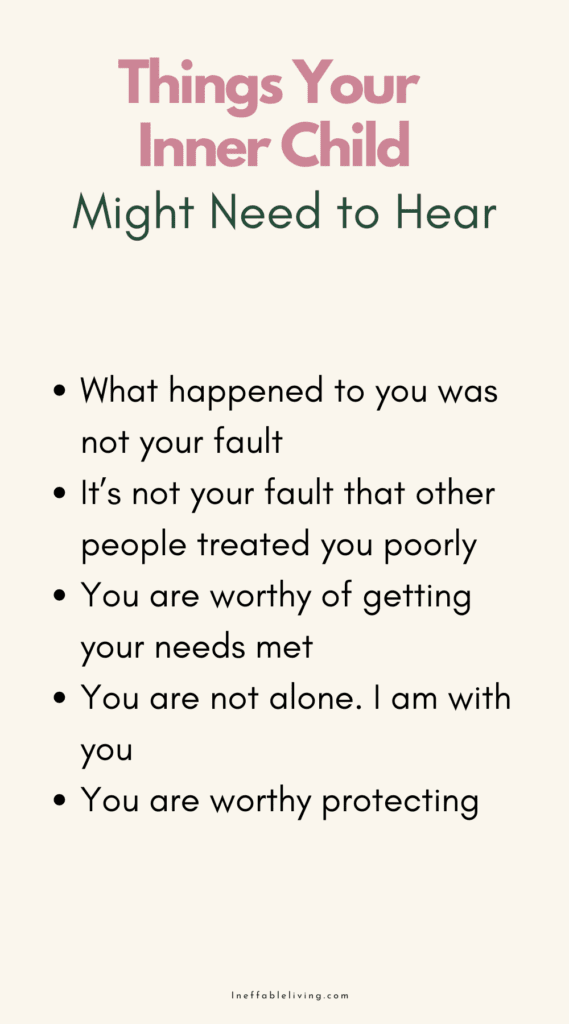This post contains inner child journal prompts that will help you reparent yourself and heal your inner child.
What Is Inner Child?
Your inner child is the part of your subconscious mind that has been absorbing events and emotions from childhood.
Our inner child also represents the part of us that is creative, mischievous, expresses joy, and feel hope for the future.
When we go through traumatic stress during childhood, the inner child becomes wounded. This affects who you are as an adult and can cause self-sabotaging behaviors.
By re-parenting yourself, you get to heal your inner child’s wounds and stop self-sabotage.
Related: Inner Child Wounds Test (+4 Attachment Imagery Exercises To Heal Inner Child Wounds)
Inner Child Journal Prompts
1. What was your childhood like? Was it generally happy? Stressful? Sad?
2. What is your first memory?
3. What did you do for fun as a child?
4. What did you want to be when you grew up? Have you fulfilled that? Did your dream change?
5. Who was your childhood hero? What did you like about them?
6. Who were your favorite teachers? What did you like about them? As an adult, do you possess these qualities now?
7. What always fascinated you as a child?
8. What activities did you enjoy as a child?
9. Did you have an imaginary friend as a child? Write about them.
10. Did you have a ‘safe space’ as a child? If so, what was it like and what did it make you feel?
11. When you were a child, how did you imagine your life would be when you as a grown up?
12. Describe a time when someone hurt your feelings as a child.
13. How do you feel when you’re around children?
14. What do the terms “childish” or “childlike” mean to you?
Related: Inner Teenager Healing: 14 Proven Exercises to Heal Your Inner Teenager
15. What was your relationship with your parents like as a child? What’s it like now? How do you feel about this?
16. Other than your parents, who were you close to as a child? Are you still close? What happened?
17. What traits did you have as a child that you still have? Which traits did you have but ‘grew out’ of? Why was this?
18. Did anyone shame you growing up? If so, what did they shame you about?
19. Were you ever told to hide certain parts of you that others deemed ‘inappropriate’? How does this make you feel now?
20. What is your negative self-talk about?
Related: Top 10 Signs Of Toxic Shame In A Person (+Best 20 Healing Shame Exercises)
21. Did your caregivers encourage you to express difficult emotions, like hurt or anger? Were you taught to suppress these emotions?
22. How do you usually soothe your inner child or deal with emotional discomfort?
23. What makes you feel anxious? What triggers these feelings? Where do these feelings stem from?
24. Do you prioritize yourself? If not, why?
25. How do you sabotage your life?
26. What negative beliefs do you have about yourself? Where did they come from?
27. What makes it hard some days to know you are loved?
28. What sort of situation or person feels good to you? Why?
29. What sort of situation or person does not feel good to you? Why?
30. Whose voice is inside your head?
31. From whom, where, or how did you acquire the belief that you are less-than?
32. Imagine yourself sitting in front of your child-self right now. What would you say to them?
Related: Best 15 Inner Child Exercises: How To Connect With Your Inner Child (& Heal Your Childhood Wounds)
Inner Child Healing Exercises PDF
How to Use Inner Child Journal Prompts?
Using inner child journal prompts can be a helpful and therapeutic way to connect with your inner child and explore past experiences or emotions that may be affecting you in the present.
Here’s how you can effectively use these prompts:
1. Find a quiet and comfortable space
Choose a peaceful environment where you can relax and focus on your inner thoughts and feelings without distractions.
2. Set a specific time
Dedicate a specific time for your journaling practice.
This could be daily, a few times a week, or whenever you feel the need to connect with your inner child.
3. Choose a prompt
Select a journal prompt that resonates with you.
It could be related to a specific event, emotion, or aspect of your inner child’s experiences.
Related: Self-Abandonment: Top 5 Ways To Get Back In Touch With Yourself
4. Reflect and write
Read the chosen prompt and allow it to evoke memories, emotions, or thoughts related to your inner child.
Write freely and honestly without judgment or self-editing.
Let your inner child’s voice guide your writing.
5. Explore emotions and insights
As you write, explore the emotions that arise.
Acknowledge any pain, sadness, or unresolved issues that surface.
Allow yourself to express your innermost feelings and thoughts.
6. Be compassionate and nurturing
Approach your writing with self-compassion and nurturing energy.
Offer reassurance and understanding to your inner child.
Provide comfort and support through your words.
7. Reflect on patterns and healing
Review your journal entries regularly to identify patterns or recurring themes.
Look for areas where healing or growth is needed.
Consider seeking professional help if deeper emotional wounds or trauma emerge.
Related: Listen to Your Inner Guidance: A Beginner’s Guide To Meditation
Conclusion
Using inner child journal prompts can be a powerful tool for self-discovery and healing, but it’s important to proceed at a comfortable pace.
Take breaks when needed, be patient with yourself, and engage in self-care practices alongside your journaling journey.

References
- Inner child – Wikipedia
- 8 Tips for Healing Your Inner Child (healthline.com)
- Inner Child: Healing Your Inner Child | BetterHelp
- What Is Inner Child Work? A Guide To Healing Your Inner Child | mindbodygreen
- Health throughout the lifespan: The phenomenon of the inner child reflected in events during childhood experienced by older persons – PMC (nih.gov)
- The Wounded Inner Child | CPTSDfoundation.org



